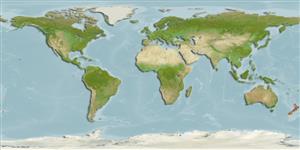分類 / Names
俗名 | 同種異名 | Catalog of Fishes(屬, 種) | ITIS | CoL | WoRMS | Cloffa
Teleostei >
Blenniiformes (Blennies)
鱸形目 (Blennies) >
Tripterygiidae (Triplefin blennies)
三鰭鳚科 (Triplefin blennies) > Tripterygiinae
Etymology: Bellapiscis: Latin, bellum = war + Latin, piscis = fish.
More on author: Günther.
Environment: milieu / climate zone / depth range / distribution range
生態學
海洋 居於水底的; 非遷移的; 深度上下限 0 - 5 m (Ref. 9003). 溫帶
Southwest Pacific: endemic to New Zealand.
西南太平洋: 紐西蘭的特有種。
大小 / 重量 / 年齡
Maturity: Lm ? range ? - ? cm
Max length : 7.5 cm SL 雄魚/尚未辨別雌雄; (Ref. 9003)
簡短描述
型態特徵 | 形態測量圖
背棘 (總數): 18 - 21; 背的軟條 (總數): 10-14; 臀棘 2; 臀鰭軟條: 20 - 23
Facultative air-breathing (Ref. 126274); Adults occur in rock pools and surge zones. They may remain out of water under rocks or seaweed (Ref. 31184). They feed on mollusks and minute crustaceans, including barnacles. This agile species eludes predators by alternately remaining motionless, then rapidly darting to a new location. Feeding occurs even in the swash zone where the fish rapidly darts with the surge and clinging to the rock as the water recedes, often being left exposed on the damp open rock (Ref. 26966). Eggs are hemispherical and covered with numerous sticky threads that anchor them in the algae on the nesting sites (Ref. 240). Larvae are planktonic which occur primarily in shallow, nearshore waters (Ref. 94114). They breathe air when out of water (Ref. 31184).
出現於岩石區潮池與湧浪區。 成魚侷限於潮池了。 可以停留在岩石或海草下面離開水面.(參考文獻 31184) 吃軟體動物與細小的甲殼動物,包括藤壺。 這敏捷的種逃避掠食者被保持不動的, 然後快速地衝出到一個新的地點。 進食甚至在魚快速地以湧浪衝出的浪花區中出現而且附著於岩石當水後退, 時常在潮溼的開放岩石上被露出在外.(參考文獻 26966) 呼吸空氣當離開水面.(參考文獻 31184)
Life cycle and mating behavior
成熟度 | 繁殖 | 產卵場 | 卵 | 孕卵數 | 仔魚
Eggs are deposited over the undersurface of a rock where they are fertilized and guarded by the male (Ref. 9003).西南太平洋: 紐西蘭的特有種。
Fricke, R., 1994. Tripterygiid fishes of Australia, New Zealand and the southwest Pacific Ocean (Teleostei). Theses Zool. 24:1-585. (Ref. 13227)
人類使用
漁業: 沒有興趣
更多資訊
年龄/大小成長長度-重量長度-長度長度-頻率形態測量圖型態特徵仔魚稚魚動力學入添量豐度BRUVS
參考文獻養殖養殖資訊品種遺傳學Electrophoreses遺傳率疾病加工NutrientsMass conversion
合作者照片Stamps, Coins Misc.聲音神經毒速度泳型鰓區Otoliths腦重體重比眼睛色素
工具
特別的報告
下載 XML
網路資源
Estimates based on models
Preferred temperature (Ref.
123201): 12.8 - 18.7, mean 16.1 °C (based on 114 cells).
Phylogenetic diversity index (Ref.
82804): PD
50 = 0.7500 [Uniqueness, from 0.5 = low to 2.0 = high].
Bayesian length-weight: a=0.00794 (0.00346 - 0.01822), b=3.08 (2.88 - 3.28), in cm total length, based on LWR estimates for this (Sub)family-body shape (Ref.
93245).
營養階層 (Ref.
69278): 3.5 ±0.4 se; based on diet studies.
回復力 (Ref.
120179): 高度, 族群倍增時間少於 15個月 (Preliminary K or Fecundity.).
Fishing Vulnerability (Ref.
59153): Low vulnerability (10 of 100).
